What to do in your allotment in July
Written by Lee Senior
July is a wonderful month with long lazy days and many plants reaching their peak. In fact, recent warm and dry weather has caused rapid growth at my allotment. It never ceases to amaze me just how quickly courgettes develop when conditions are just right!
There are plenty of crops to harvest this month, especially for those who started their seeds and plants off early in spring. But it’s important to keep on top of routine maintenance tasks too, like hoeing and keeping a lookout for pests. Remove any destructive caterpillars as you see them, hopefully before they do too much damage.
While July is a time of plenty, it’s also a good moment to look ahead and plan for winter and next spring. For instance, spring cabbage can be direct sown into an outdoor seed bed now, and thinned out later for harvesting next April and May. If you fancy growing late season new potatoes for Christmas, now’s the time to order the tubers. Plant them towards the end of the month or in early August.
Happy gardening!
Allotment flowers in July
- Mid-summer is the glorious height of the sweet pea season. There’s nothing better to lift your spirits than the striking colours and subtle scents of this venerable old flower. Cut regularly to ensure a constant supply of new blooms – cropping is reduced if spent flowers remain on the plant and form seed pods.
- Sow Sweet William ‘Pinocchio’ seeds into your allotment beds this month. The seedlings happily overwinter outdoors and produce flowers in late spring the following year.
- Deadhead your flowering perennials and allotment bedding plants to encourage repeat flowering through the entire summer.
- Plant any spare marigolds and tagetes near tomatoes to help deter whitefly. Flowering companion plants help attract pollinating insects to your vegetable patch too.
- Try leaving a vegetable plant in the ground to ‘go over’ and flower. Not only are parsnip and brassica flowers particularly lovely to look at, they attract pollinators and allow you to save your own seeds.
- Herbs like sage and rosemary are currently in flower, and both look great on the allotment as well as having practical uses too.
- Stake tall summer-flowering bulbs like gladioli to prevent the stems snapping on windy days.
- Stake sunflowers sufficiently well to avoid them being blown over during strong winds. There is a considerable amount of stress on the stakes due to the height of the plants.
Allotment vegetables in July
- There’s still time to sow follow-on crops of beetroot and French bean seeds.
- Continue to sow fast-maturing summer salad crops like radish. If you grow lettuce, remember to pick them as soon as they are ready as most varieties will quickly bolt if they are left to stand in the heat.
- Make sowings of turnip ‘Purple Top Milan’, pak choi and kohlrabi ‘Purple and White Vienna Mix’ for quick maturing crops that will be ready at the end of this summer.
- The first couple of weeks of July are ideal for a late-summer sowing of carrots. ‘Fl Purple Haze’, ‘Amsterdam Forcing 3’ and ‘Autumn King 2’ are all suitable. ‘Autumn King’ is a hardy variety that can be stored in the ground and harvested up until Christmas.
- Direct sow Chinese cabbage ‘F1 Natsuki’ this month. Harvest the sweet, tender heads 35 – 45 days after sowing, and stir fry whilst they’re small. Make a late sowing of spring cabbage for harvesting next spring too. I also like ‘Wheelers Imperial’.
- Both Chicory and radicchio can be sown now for use over the colder months.
- Sow other brassicas like broccoli and cauliflower in early July for a harvest next spring. These hardy plants will mature and overwinter out on the plot.
- Start swede seeds out on the plot. Make sure you water the seedlings well as they develop, and protect them with mesh to deter flea beetles.
- Sow herb seeds like parsley straight into the ground, or start them off in trays before transplanting the seedlings into decorative pots for your kitchen windowsill.
- Now’s the time to plant late season potatoes. Varieties like ‘Nicola’ will mature quickly in the warm summer soil and provide you with a crop from October to December. Earth up your potato plants as required and keep an eye out for any early signs of blight.
- Young pumpkins and squashes should be forming nicely by now. They can be grown either clambering up trellis, over compost heaps and indeed along the ground. Keep the plants well watered.
- Keep favourites such as courgette and runner beans moist for them to give their best.
- Watch your onions carefully and cut out any flower spikes that emerge. This encourages them to focus on putting on size.
- If you haven’t done so already, lift autumn-grown garlic early in July. Allow the bulbs to dry in a sunny location before storing for use over winter.
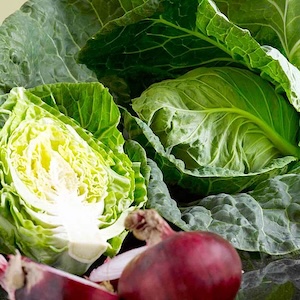
Image: Cabbage ‘Wheeler’s Imperial’
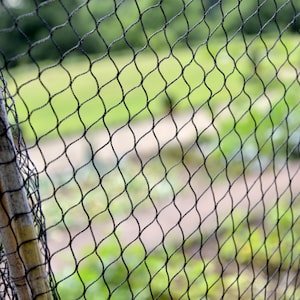
Image: Superior Fruit Cage Net
Allotment fruit in July
- Your strawberry plants are sending out runners which can be pegged into small pots of compost to make new plants. When the runners have rooted, simply detach from the parent plant. Strawberry plants last for three years before the fruit deteriorates to the stage where the plants need replacing.
- Water blueberries regularly to help the little fruit swell. Try to use collected rainwater to maintain their preferred soil acidity.
- Keep all currant bushes well watered as they enter the cropping phase
- If you haven’t already done so, net your fruit plants to keep the birds off. This is especially important with juicy strawberries and currants.
- Gooseberries are beginning to ripen. Gooseberries generally crop heavily once established and they need little pruning. The bushes are generally long-lived too.
- Prune your apple trees this month, removing excessive whippy new growth using clean sharp secateurs. Avoid cutting older growth or removing fruit bearing branches.
- Apple trees have a ‘June drop’ of young fruitlets between early June and early July. This is when the tree rids itself of small fruits if there are too many for it to carry through to maturity. Young trees are especially prone to this. In mid-July, check to see if there are still too many fruits and thin out if necessary. If the tree carries too many apples in one year, the following year may be disappointing.
Crops to harvest in July
- There’s a delicious bounty of tasty homegrown food this month! The first of the greenhouse tomatoes should be ready to eat and those juicy, red, deliciously-sweet strawberries are now cropping heavily.
- Harvest beetroot, broad beans, summer cabbage, early-sown carrots, courgettes, lettuce, peas, radish, and salad leaves this month for a truly veritable feast!
- Some early-sown cauliflowers might be ready this month.
- Harvest onions and garlic when the foliage starts to turn yellow and wilt. Eventually the foliage will flop to the ground. It’s important to let the bulbs dry thoroughly before storing in a cool dark place for use throughout the rest of the year.
- Summer strawberries will continue to crop until around mid-July.
- Gooseberries, blackcurrants, redcurrants and whitecurrants are all coming into season now.
- First early potatoes are at their most prolific now and I’ll be digging my plants up this month and preparing the ground for a follow-on crop.
- Check a few second early potatoes to see if they’re a good size for harvesting.
- Pick your mangetout and sugar snap peas regularly.
- Harvest your pak choi either as ‘cut and come again’ leaves, or chop up the whole thing into a stir fry or noodle soup.
- Try harvesting the male flowers of your courgette plants to stuff and deep fry, or to decorate salads. Courgettes need regular picking, otherwise you’ll end up with lots of marrows to deal with!
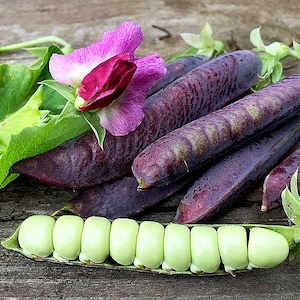
Image: Pea Blauwschokker
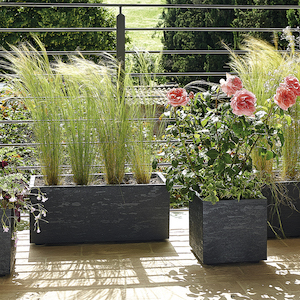
Image: Gravity Pots – Charcoal
General July allotment jobs
- Check your fruit cage netting regularly for trapped birds. I once had to rescue a young blackbird that had somehow got in, but couldn’t find any way to escape.
- Aphids, cabbage white butterfly, carrot flies and slugs and snails are the main pests to watch out for at this time of year.
- If slugs are a problem consider the use of nematodes. These living organisms provide effective biological control for up to six weeks.
- Hoe regularly during dry weather to keep on top of weed seedlings and thereby reduce competition for vital moisture.
- Apply well-rotted manure to your allotment beds when the soil is moist. This improves water retention and helps plants cope with dry spells.
- If you run out of space in your beds, don’t forget to make full use of containers. Just remember that they’ll need more watering.
- Consider installing a water butt to avoid queues for the tap and rethink your plot design if you find summer watering difficult. Raised beds dry out more rapidly than regular beds, and you could steer towards vegetables and herbs that naturally cope better with drought.
- In the hotter months like July and August, try to water your crops in the early morning or evening to reduce evaporation.
Planning ahead
- If you take on more space and need to clear large thickets of weeds, concentrate on clearing small areas at a time. If you get a few quick salad crops in you’ll make good use of the ground while using the rest of the month to plan for next year. If your new patch can be cleared by early September, prepare to plant spring cabbage and winter lettuce. In autumn, you can plant garlic and onion sets to overwinter.
- If you’re planning on going away in August, remember that your tomatoes and cucumbers are very water sensitive. Make sure you install an automatic watering system in your greenhouse if you have them under glass. Alternatively, ask a friendly allotment neighbour to keep an eye on watering in exchange for a bit of your crop.
- Make note of what’s working well. These notes will help you plan better for next year’s planting and seed buying.
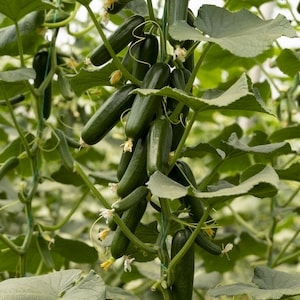
Image: Cucumber Ayda
Suttons Seeds recommend these areas which may also be of interest.
- Previous month: What to do in your allotment in June
- Next month: What to do in your allotment in August


